Draft Banbridge Place Plan
 Armagh Banbridge and Craigavon Community Planning Partnership
Armagh Banbridge and Craigavon Community Planning Partnership


 Welcome to Banbridge Mural Artist Holly Pereira // Photographer Edward Byrne Photography
Welcome to Banbridge Mural Artist Holly Pereira // Photographer Edward Byrne Photography

 Armagh Banbridge and Craigavon Community Planning Partnership
Armagh Banbridge and Craigavon Community Planning Partnership


 Welcome to Banbridge Mural Artist Holly Pereira // Photographer Edward Byrne Photography
Welcome to Banbridge Mural Artist Holly Pereira // Photographer Edward Byrne Photography
The Armagh, Banbridge & Craigavon Community Planning Partnership, are pleased to present the second Place Plan for the Borough.
The Banbridge Place Plan details 56 tangible and measurable collaborative actions that will contribute to a better Banbridge. The Plan is the result of a comprehensive engagement process with the people who live and work in Banbridge. It is supported by strategic and policy research.
Starting with the Past and Present of Banbridge (Ch.1), the Place Plan lays out the story of the town. The vision of the Place Plan (Ch.2) paints a picture of a future Banbridge, Celebrating our Innovators and Independents and Welcome to the Banbridge of Tomorrow.
The Introduction to the Place Plan and Process (Ch.3) gives an overview of the place planning process and it shares how the discovery stage has provided an evidence base for the plan. Strategic Alignment (Ch.4) details the alignment opportunities that exist across government and with wider stakeholders.
A focus on Engagement (Ch.5) shares how broadly and deeply people have been engaged throughout the development of the plan and shares the highlights of this process. Challenges and Opportunities (Ch.6) are highlighted through a health check for the town, building on the strong assets that already exist.
The Outcomes (Ch.7) describe the change that Banbridge will undergo: Bridging, Green, Healthy, Creative, Growing. The Actions (Ch.8) are clustered into 5 areas: Arts, Heritage and Leisure; Green Innovation; Spaces, Places and Natural Environment; Living Here; and High Street and Investing. Finally, the Banbridge Place Plan is summarised through a Theory of Change (Ch.9) style diagram.
Accompanying documents to the Banbridge Place Plan are:
• Discovery Report

The Discovery Report complements the Banbridge Place Plan by documenting desktop research, and providing an evidence base for the plan - a starting point. The report
provides the geographical, historical, social and strategic context for the Place Plan. It also provides a town centre analysis and health check for Banbridge in 2023, and beyond.
• Engagement Report
This report summarises the engagement with the people of, and stakeholders in, Banbridge that have been carried out throughout the Banbridge Place Plan, the activities that were undertaken and the findings that emerged.


















































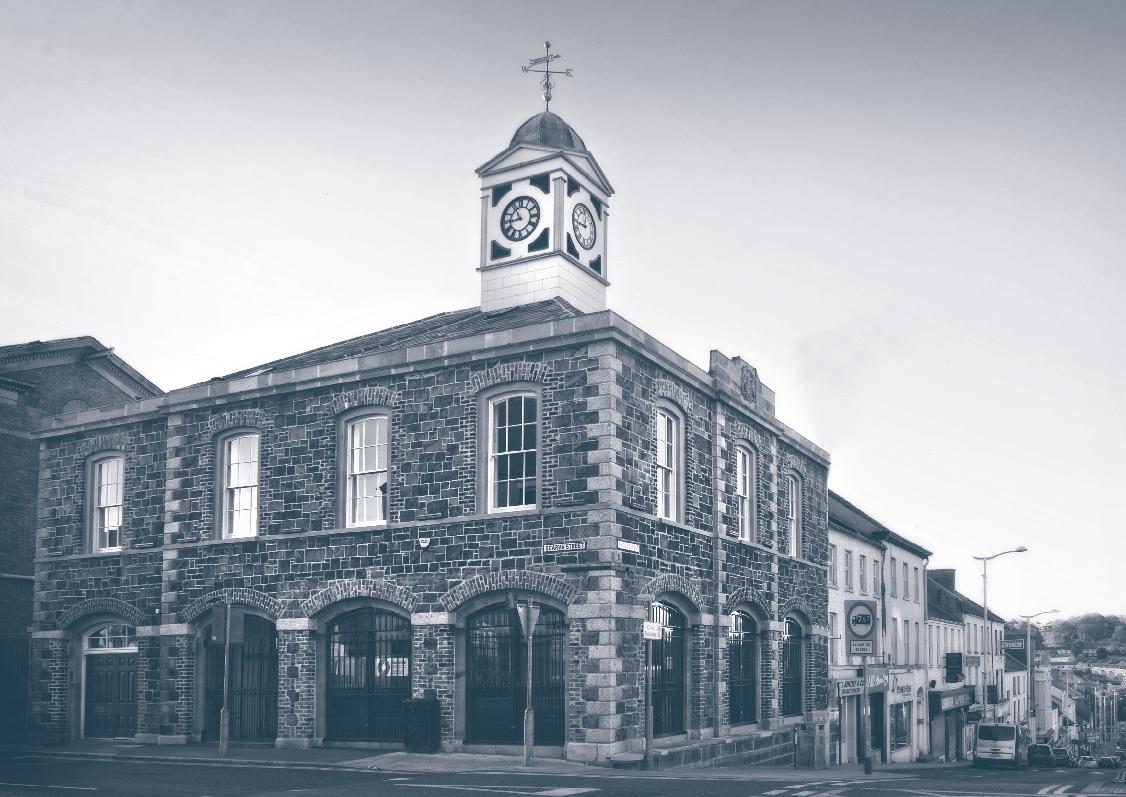
‘Banbridge is an attractive markettown, once a great centre of the linen trade, placed where the main DublinBelfast road crosses the river Bann. The road rises and dips through rolling country, and then falls steeply to the riverside; the centre of the town bestrides the ridge (and the cutting engineered through its summit) above the crossing. The application of waterpower to textile manufacture in the first half of the 18th century brought great prosperity to the valley of the Bann, and Banbridge still retains something of the homely affluence of the period when it was an important textile trading market. There are very many terraces (some now decrepit) of the late 18th and early 19th centuries, mostly very modest, but they nevertheless give the town a decided and agreeable character of its own.’ Brett & Dunleath (1969) List of Historic Buildings, Groups of Buildings and Areas of Architectural Importance in the Borough of Banbridge, Belfast: Ulster Architectural Heritage Society.
Bustling Banbridge is birthplace to globally known artistic, literary and scientific innovators such as sculptor F.E. McWilliam; The Bronte and Yeats

families; Arctic explorer Captain Crozier; Nobel prizewinner Ernest Walton: and Poet Joseph Scriven. Its linen industry once supplied the finest Jacquard in the world and Thomas Ferguson’s Factory is still recognised for fabric production. The landscape of the town is defined by the River Bann, although it is ‘so laid out that it tends to turn its back on the river which flows through it in a charming S-bend.’ Brett & Dunleath (1969) This natural features juxtaposes with the man-made feat of engineering locally known as The Cut, which is said to be Ireland’s first underpass. In the outskirts of the town, ‘there are mills and factories both new and old; and there are a number of new housing estates and suburbs’ Brett & Dunleath (1969)
Banbridge’s architecture consists of a mixture of late Georgian, Victorian and Edwardian buildings, with a remarkable 139 listed buildings and structures. Three Areas of Townscape Character (ATCs); Banbridge Town Centre, Hayes Park and Peggy’s Loaning, have been designated to acknowledge the distinct heritage of these areas and protect their historic environment.
Today, Banbridge is home to 17,400 people. Its schools and colleges continue to inspire new ideas and innovation, and it is now the site of the global visitor attraction HBO’s Game of Thrones Studio. The town is known for its array of independent traders, eateries and makers and The Boulevard boasts a complementary offering of designer brands and household names. Annual celebrations such as Buskfest amaze and delight, offering a place and a stage for local and travelling talent.
Banbridge enjoys an enviable location surrounded by parks, woodland and visitor attractions, and is strategically located on the Belfast Dublin Economic Corridor, with the A1 providing quick links to the island’s airports and major cities. There are a wealth of entrepreneurs and businesses already based in the town, and great potential for others to follow suit, locating their businesses in Banbridge to take advantage of all the town has to offer as a strategic business location.


















































An inspiring town, where generations-old, family-run independent businesses are thriving, alongside multinational businesses and exciting markets.

A town of innovative industries and active citizens, makers, and discoverers, that celebrate and share its rich heritage and make it an even better place to live
An inviting hub of opportunity, and place to recharge along the Belfast Dublin Economic Corridor (BDEC)
A town that places importance on its river, as a source of leisure, biodiversity and green power
The vision for Banbridge is a town of explorers and innovators, writers and sportspeople, independents and makers, past and present. Coming to visit, you can’t miss the turnoff for Banbridge, as the iconic Bow Breaker artwork appears in your sights approaching along the A1. You are guaranteed EV fast charging points here, and public toilets, so why not check out the town while you wait and experience a warm welcome, great shopping and restaurants.
A town built around a river that is once again the focal point of its activities, with footbridges and boardwalks to enjoy a stroll whilst watching the kayakers and ducks pass by. It’s a vibrant market town with lots of places to eat, shop and play, and with public transport and routes that work for local people, around their work and leisure hours. Why not sample the fine local produce at many of our independent retail businesses?
A network of smooth, accessible walks and trails around the town with space for prams, scooters and wheelchairs. On a walk you can you can learn about
the town’s heritage and biodiversity while you get some exercise and fresh air. Ride your bike along the Scarva Greenway to catch the train or continue on the Newry Canal towpath. A programme of community events are popular and well attended, including the weekly park run and the everpopular Buskfest, which now has a year-long programme of feeder events that build-up to the festival itself.
Solitude Park is abuzz with summer theatre events in the amphitheatre, skaters, children playing and parents queuing up for coffee from the cart and the town centre streets are safe and enlivened long into the evenings. The FE McWilliam art gallery keeps getting better, as does the public art across the town, the community theatre, community garden and allotments. The Library has become a 24-7 hub for all ages to meet, learn, and conduct research including local history and your family tree.
Award winning start-ups take space in the expanded enterprise hub or other office and co-working spaces across the town centre. As businesses grow,

there are spaces for them to expand into, where they can enjoy the smart infrastructure and connectivity the town has to offer.
Creative talent graduating from the SRC can find jobs and homes right in Banbridge, if they don’t want to leave, and why would they? If you don’t already, then perhaps you would like to live here, too, with all this on your doorstep and an easy commute as far as Belfast, Dublin and everything in between.


















































Vision of Connected: A Community Plan for Armagh City, Banbridge & Craigavon Borough 2017-2030
The creation of new community planning functions as part of Local Government Reform 2015 brought together key partners to work collectively for the communities that they serve. In 2017, Connected, the Community Plan for the Armagh, Banbridge and Craigavon Borough was developed, and it identified opportunities for the ABC Community Planning Partnership to work together and with the community to ensure that connectivity, equality and sustainability lie at the heart of
all they do collectively, for the good of the Borough.
In 2022, after the development of its first Place Plan for Armagh, the Community Planning Partnership agreed to continue the development of Place Plans for urban centres in the borough. The place plan process brings together a wide range of partners, businesses and the community to shape the direction of Banbridge, recognising, the need to take a ‘whole town’ approach and work together.
‘We have a happy, healthy and connected community, a vibrant and sustainable economy and appealing places for living, working and learning’
Place shaping provides an opportunity for the Armagh, Banbridge and Craigavon Community Planning Partnership to work together with local people and stakeholders, unlocking innovation and change, to improve the quality of life in our places across the Borough for the benefit of all. Participation of local people and local communities is essential in this place planning process.
This Place Plan is a departure from traditional forms of master planning, towards a more hybrid, co-produced approach, at a local scale, which has a focus on well-being and puts the people of Banbridge and their views at the centre of future planning. This aligns with recent theoretical evolutions towards more inclusive community engagement practices. This is based on a belief that co-designed outcomes
will better take account of both the interrelationship between people and place, and, specifically, the complexities and singularities of Banbridge. The approach has been employed already in the Borough through the recent Armagh Place Plan (2022).
The Place Plan is not a statutory document, but it has the potential to set a framework of tangible projects and proposals for future development, to enable different stakeholders to work together to their mutual benefit and for the betterment of Banbridge, leading to more credible plans for a place that are more reflective of the people of that place.
The implementation of all the actions/ outcomes in the Plan will be subject to obtaining all the necessary consents including planning permission.

Jan 23 - Apr 23
Desktop research
Discovery and Engagement
Public Survey
Aug 23 - Sep 23
Community Planning Partnership and Council Committee approvals
Jan - Feb 24
Review of feedback and Place Plan approval
Dec 22
Initiation
Discovery Phase
May 23 - Jul 23
Development of Draft Place Plan
Draft Vision, Outcomes and Key Actions
Oct 23 - Dec 23
Public Consultation on draft Place Plan
Live engagement and workshops
Mar 24
Launch of Place Plan






















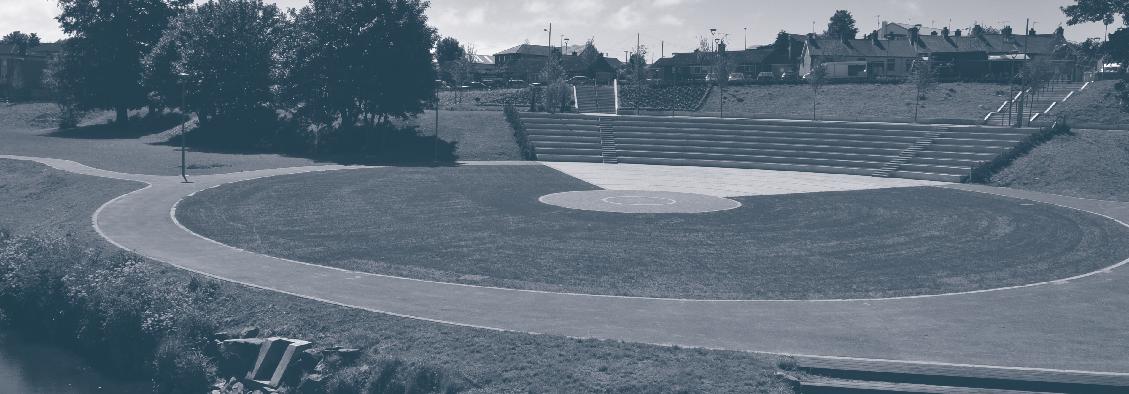




























During the place plan process, a phase of discovery was conducted including desktop research, statistical analysis of town data and strategic policy scanning. The discovery phase was informed by town walks to understand the current conditions and offering of the place. Engagement was key which will be highlighted in the next chapter.
The evidence base used in this process included;
Banbridge Statistical profile

Discovery Report
Engagement Report
A dashboard has been developed to show the current status through several indicators. The population indicators or statistics are available from NISRA, Department for Communities, Tourism NI and the Northern Ireland Housing Executive. The Community Planning Partnership will use these indicators to track progress towards realising the outcomes of this plan. 17,400
1,600
52,273
1 Census 2021, NISRA
2 Type of Crime by Town and Settlement for Banbridge 2021. Source: Police Service of Northern Ireland Statistics, via Town Centre Database, Department for Communities.
3 Road Traffic Collisions in Banbridge Town Centre 2020. Source: The Northern Ireland Town Centre Database, Crime and Road Traffic Collision Data.
4 City/town centre non-domestic property vacancy rates as at 30 April 2023. Source: Land and Property Services via Town Centre Database, Department for Communities.
5 Business Demography in Banbridge Town Centre (2021). Source: InterDepartmental Business Register, NISRA Economic and Labour Market Statistics Branch via Town Centre Database, Department for Communities.
6 Employee Jobs in Banbridge Town Centre, 2021. Source: Business Register and Employment Survey, NISRA Economic and Labour Market Statistics Branch via Town Centre Database, Department for Communities.
7 Inter-Departmental Business Register (2023), NISRA.
8 ISRA, Claimant Count. Monthly Claimant count in Banbridge Proxy Area, June 2023. Includes Jobseeker’s Allowance Claimants and those Universal Credit claimants who were claiming principally for the reason of being unemployed.
9 Footfall by day in Banbridge Town Centre, Week 26, 26 June – 2 July 2023.
Source: Springboard Analytics.
10 Visitor numbers to FE McWilliams Gallery 2022. Source: Banbridge Tourist Information Centre.
11 Historic Environment Division, Department for Communities
12 Social housing need in Armagh City Banbridge and Craigavon Borough 2022-27.
Source: Northern Ireland Housing Executive & Armagh, Banbridge & Craigavon Commissioning Prospectus data 2022.
Car Parks Hedgerows




Car Parks (council owned/paid) Hotels
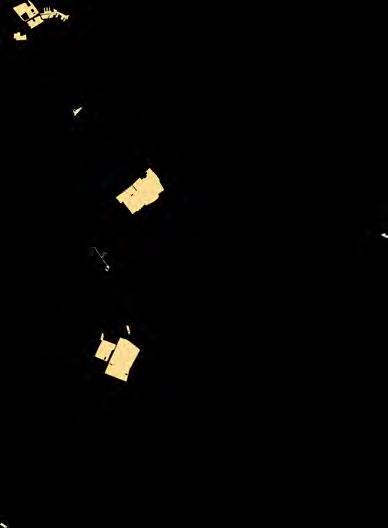
Civic Buildings Holiday Accommodation
Commercial buildings Houses
Council-owned areas Listed buildings

Eateries Areas of Townscape Character
Education buildings
Flood risk areasclimate change






Green spaces


Activity areas



Planned major developments: Businesses
Planned major developments: Banbridge High School Pitch
Planned major developments: Building Control applications
Recreation




Free play areas Religious buildings
Play parks Factories / industrial buildings
Health buildings Transport buildings
This is Crown Copyright and is reproduced with the permission of Land & Property Services under delegated authority from the Keeper of Public Records, © Crown copyright and database right 2023 CS&LA581. Map produced August 2023.








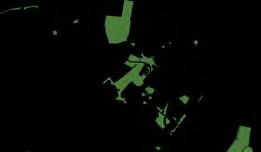
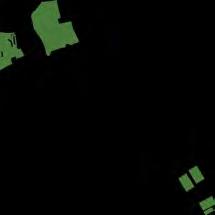

During the Discover phase, a strategic analysis of policies and strategy was carried out to identify common themes and to ascertain what alignment opportunities exist across government and with wider stakeholders. The desktop analysis determined five key areas of alignment for the Banbridge Place Plan which are reflected through the five outcomes. Five spatial levels present the global to the local, from the UN Sustainable Goals to previous plans for the town of Banbridge.
Policy or Strategy Document
Global The 2030 Agenda - UN Sustainable Goals, 2015
UK Wide UK Net Zero Strategy: Build Back Greener, 2021
Island-wide All-Island Strategic Rail Review (DoT & DFI), 2023 (draft)
NI and regional Draft Programme for Government 2016-2021
Regional Development Strategy 2035
NI Domestic Tourism Strategy, 2020
MAG Living High Streets Craft Kit, 2022
Integrated Tourism Development & Marketing Strategy & Action Plan 2017-2022
Strategic Planning Policy Statement (DFI) 2015
Inspire Connect Lead: A 5 year Framework for Developing the Arts 2019-2024 (ACNI)
Banbridge Place Plan Outcomes BridgingGreenHealthyCreativeGrowing
Banbridge Place Plan Outcomes
Policy or Strategy Document
NI and regional 10X Economy: An Economic Vision for a decade of innovation, (DfE)
Economic Recovery and Action Plan, (DfE)
The Mental Health Impact of the COVID-19 Pandemic in Northern Ireland
Invest NI Council Briefing, 2021
High Street Task Force Delivering a 21st Century High Street, 2022
Housing Supply Strategy 2022 - 2037
Green Growth Strategy for Northern Ireland
Sustainability for the Future - DAERA’s Plan to 2050
Council Wide Connected Community Plan, 2017-2030
ABC Corporate Plan, 2018-2023
ABC 25 UK City of Culture Bid, 2022
ABC Recovery and Growth Framework
Arts, Culture and Heritage: A Framework for the Future 2021-2031 (CPSP)
Armagh Place Plan (ABC Council)
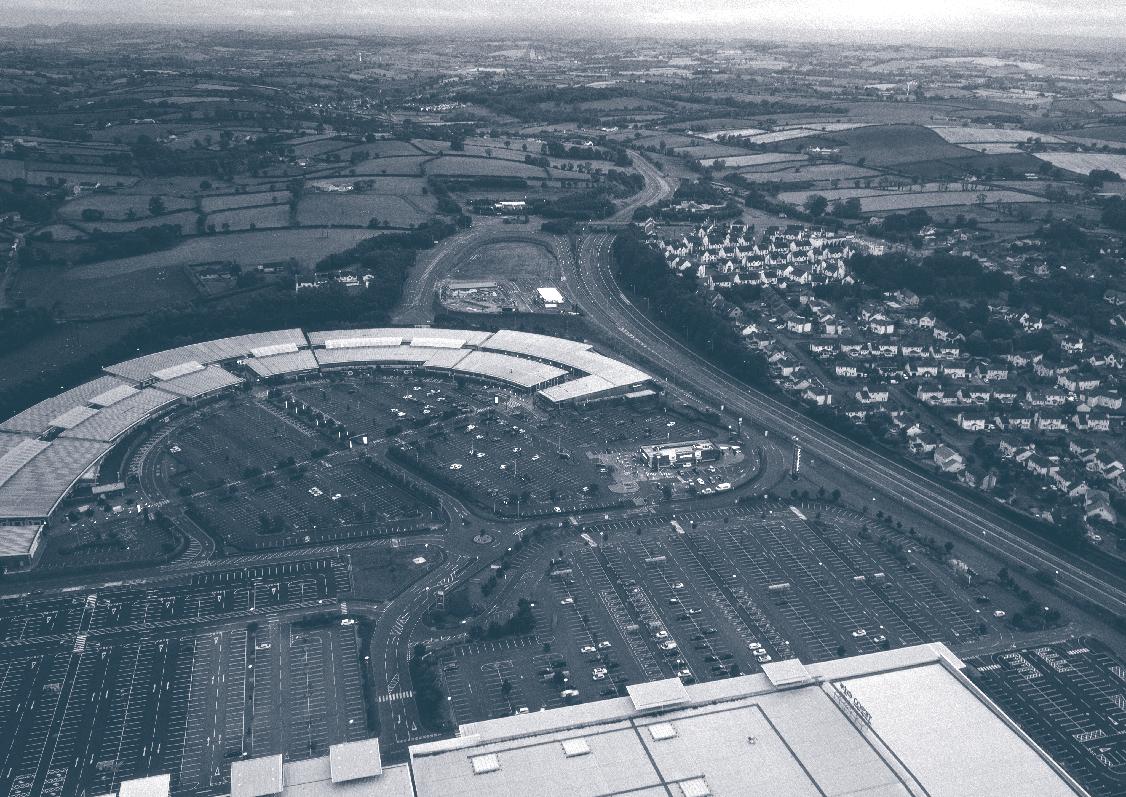
Council Wide Armagh, Banbridge and Craigavon's Car Parking Strategy, 2023 (Draft)
ABC Play Strategy 2018-2026
ABC Local Development Plan Preferred Options Paper, 2018
ABC Vacancy Study 2019
Mid South West Regional Economic Strategy
ABC Environmental Policy Statement, 2018
ABC Open Spaces Strategy
ABC Air Quality Action Plan, 2022-2024
ABC Allotment Survey
Banbridge Banbridge Public Realm Project
Banbridge Town Centre Masterplan, AECOM, 2016
Banbridge A Vision for the Future, Ferguson McIlveen, 2000
Banbridge Riverside Parkway Plan, WJ Cairns & Partners, 1977
Banbridge / Newry and Mourne Area Plan, 2015
Banbridge Place Plan Outcomes
BridgingGreenHealthyCreativeGrowing






















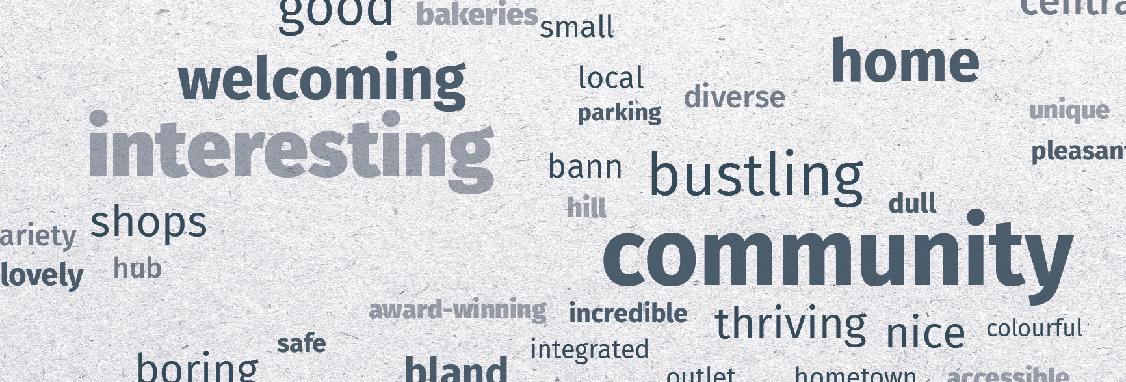





























The purpose of the engagement was to gather as many diverse opinions and aspirations for Banbridge as possible, to be truly reflective of the town and its people. This was done through a means of collaborative methods that are set out in the accompanying Engagement Report, including memory mapping, collective reimagining, walking, one-word ice-breakers, postit note brainstorming, SWOT analysis and Lego building, spread across focus groups, workshops, one-to-one interviews and the Place Lab.
Throughout the engagement everyone, young and old, who lives, works, visits, plays or has a strategic interest in Banbridge were invited to share what their big (or small) idea was for Banbridge. The goal was to capture ideas of all scales - nothing too big or too small - that could bring about positive change in the town. Answers were gathered verbally from conversations, in writing through the
questionnaires, post its, drawings and text left on graffiti sheets that asked open ended questions. Responses ranged from the radical to the everyday - from bringing back train stations to all sorts of arts and theatres and trampoline parks, from bridges and ring roads to allotments and wildflower verges. An extended list of 99 ideas can be found in Appendix 1 of the Engagement Report.
The many rich conversations, opinions and ideas shared have been refined and narrowed down to those that reflect, as best as it can be defined, the collective will of the diverse people and stakeholders of Banbridge.
The outcomes and actions put forward in this strategic Place Plan have emerged from ground up, creative engagement approach.
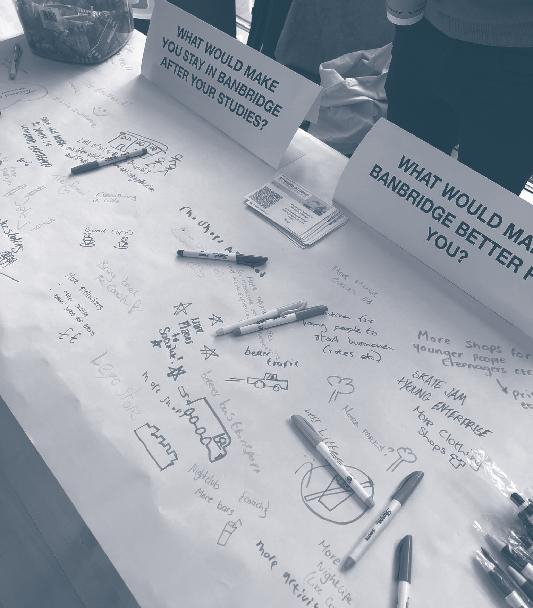




113 Young people engaged 57 older people engaged
Have VISION. Think outside of the box and DO NOT follow what other towns are doing. You need to make Banbridge DIFFERENT to other towns that way people will come for a different experience that can not be had elsewhere. // Survey response
245 respondents across two online surveys
17 meetings and interviews
21 drop-ins at the pop up Place Lab
6 workshops (online and in-person)
3 pop-ups at community events

























2 discovery walks


1. Banbridge is a friendly and welcoming place with strong community, cross-community and inter-generational connections
2. People are proud of the high number of independent shops and local artisan food offering
3. Banbridge should take better advantage of its strategic location on the Belfast Dublin Economic Corridor
4. There are many tourist and passing commuter visitors to the wider area, and passing by along the A1, but not many visit the town
5. The people of Banbridge are above average health for the borough, with over 80% identifying as enjoying good or very good health
6. People are keen to make more use of the river Bann, including extending the river walk and introductory river activities making it more accessible.
7. There is a lack of development land for new housing, business growth and start-ups. The enterprise hub, business centre and industrial lands are at capacity.
8. Public transport is inadequate, meaning cars remain essential for getting around - buses are infrequent and expensive; people (especially teenage girls) don’t cycle to commute because the infrastructure and culture are not there; people would love to have better access to a train station
9. People raised the lack of things to do in the evenings: 78% of survey respondents felt the town’s evening economy was poor to fair.
10. There is an opportunity to raise awareness of the rich local history: 70-80% of survey respondents had only basic or no knowledge of Banbridge’s heritage stories and figures, such as the linen industry, Crozier, FE McWIlliam, Joseph Scriven, the Brontes and Yeats.
11. More effort could be made to promote local events - for example 14% of survey respondents had never heard of the flower market.
12. Young and old people would like more places to spend time in the town (especially without having to spend a lot of money)
13. There is interest in community theatre and arts for Banbridge
14. There is interest in seeing the old police Barracks building revitalised by its new owners























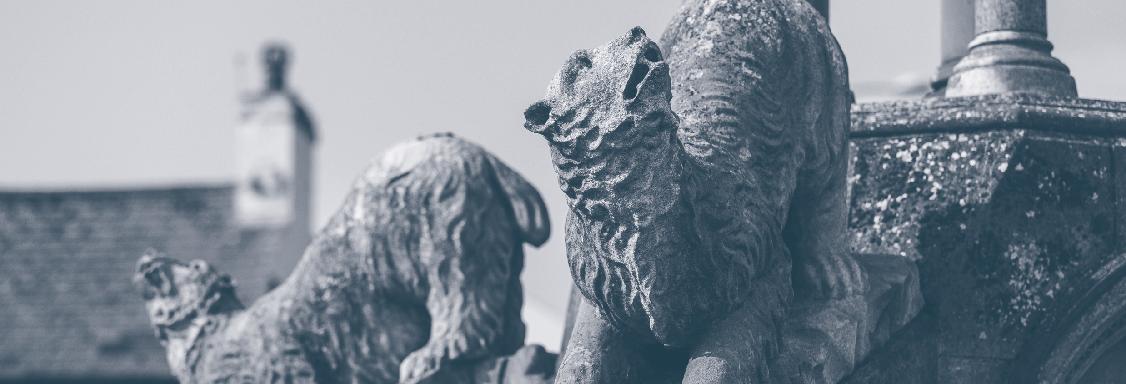



























The following challenges and opportunities bring together the engagement results and discovery phase research. A range of challenges and opportunities have been identified from engagement findings and discovery research. These have been compiled using the ‘essential qualities health check’ format from the Living High Streets Craft Kit 2023. These seven opportunities, listed below, are further elaborated in the pages that follow:
6.1 // The local landscape, culture and heritage
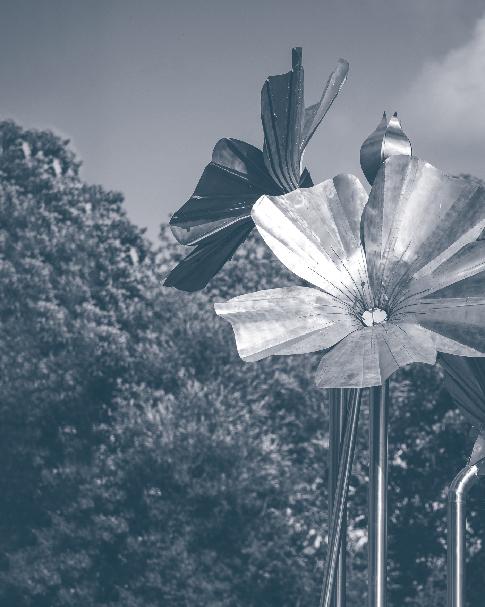
6.2 // Togetherness, collaboration and living well
6.3 // Being safe and welcoming
6.4 // Multi-layered purpose and meaning
6.5 // Having adaptable buildings and spaces
6.6 // Being well serviced and connected
6.7 // Being sustainable
The River Bann, one of the longest rivers in Northern Ireland, runs through the town centre, linking woodland and parks. However, Banbridge town currently does not embrace the river. Under 10% (Survey) of people felt the town’s connection to the river was very good or excellent - there is significant room for improvement there. There are few river activities currently on offer. This brings a huge potential to reconnect with the river that the town is named after: through programmed river activities; signage; walks: and new infrastructure.
Banbridge has a number of notable parks and gardens. Havelock Park, Huntly Wood, and Solitude Park. Solitude Park boasts an outdoor amphitheatre, skate park, river, outdoor gym, playpark and viewing platform. There is potential to increase programming to enhance park usage including the trial of a coffee cart in Solitude. The parks are all relatively small and do not connect with each other despite being close. The hilly landscape of the town creates real and perceived barriers to movement. Bridges and cycle paths could make new connections between these green spaces. This would
enhance both the local landscape and health and wellbeing, making it easier for people to enjoy commuting and leisure and creating the potential for a Banbridge Park Run.
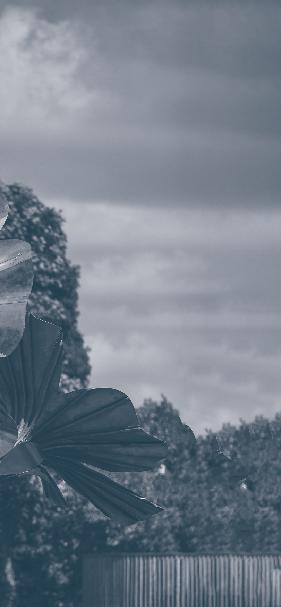
A historic market town, Banbridge has three Areas of Townscape Character; Banbridge Town Centre, Hayes Park and Peggy’s Loaning. There are 139 listed buildings and monuments within the Banbridge Settlement Development Limit. Protecting and celebrating the wealth of heritage is important to the heart and soul of Banbridge. There is potential for better promotion of the existing flower market and other markets as only 14% of survey respondents knew of them.
There are an array of historical stories and connections to Banbridge’s extraordinary places and people. 7080% of survey respondents had basic or no knowledge of these. There are opportunities to promote these stories and offer further promotion of existing trails such as Historic Trail (2002) by Banbridge Heritage Development Ltd and Banbridge Historical Society. The F.E. McWilliam Gallery and Studio is dedicated to the memory of sculptor
Frederick Edward McWilliam, one of Ireland’s most influential and successful artists who was born in Banbridge. The Gallery offers a permanent display of McWilliam’s work, temporary exhibitions of Irish and international art, a craft shop, café and Banbridge Tourist Information Centre, the F.E. McWilliam Gallery and Studio attracts a wide range of local, national and international visitors (52,273 visitors in 2022). Recently allocated Levelling Up funding (£3.5m) will expand the exhibition space, increase visitor capacity and create more engaging opportunities to host events and educational programmes. Unlocking opportunities to attract more international visitors and develop the borough as a key destination. Game of Thrones Studio Tours has the potential to reach international audiences, sharing the stories of the local landscape where filming took place, in addition to the studio sets and costumes that have been expertly made here in Northern Ireland. There is potential for an on site educational programme and opportunities for attracting visitors into Banbridge.
Banbridge’s excellent educational offering includes: 5 primary schools (one is integrated); 3 secondary schools; Donard School plus the Southern Regional College as well as a range of pre-schools and a Sure Start. Potential for shared use of educational resources such as pitches and halls offer potential assets for theatre/ community use in evenings.
Banbridge has a great sporting reputation with many excellent sports clubs including golf, tennis, table tennis, bowls, hockey, running, cycling, and angling. The leisure offering includes: Banbridge Leisure centre, Solitude Park, Havelock Park, Huntly Wood, Football pitches, GAA, Rugby, Play parks and the River Bann Walk to Dunbar Link. Again there exists the potential to enhance connections and share resources. The Open Spaces Strategy (2016) recognises the ‘... contribution that sport makes to a sense of local and national identity, to personal, moral and physical development, and individual enjoyment. Additionally, recognition needs to be given to the wider socioeconomic and health benefits of sport and recreation including job creation,
physical fitness and cross-community relationship building.’
Young people expressed a desire for an extended opening hours for Banbridge Youth and Resource Centre opening as a drop-in space. NI Libraries are evolving with the Banbridge library being one of the first to trial extended 24 hour opening for all members. Only 1 out of 15 young people in the workshop at the Education Authority youth centre said they used the library. However there is an opportunity for a library revolution, by spreading the word of extended opening and the community assets that sit within.
Cross-community and intergenerational relations in the town are strong, as reported and observed by attendees of the churches and groups workshops, and 54.8% (survey) felt that Banbridge was rated good/ very good at being inclusive and diverse.
With a 5th of the adult population in NI spending ‘too much time alone’ post Covid (according to the report: Mental Health Impact of the COVID-19 Pandemic in Northern Ireland) Banbridge has much to offer in terms of opportunities for togetherness.
There were 238 accounts of Anti Social Behaviour (ASB) in Banbridge town in 2022 and 774 within the Banbridge Settlement Area, which is a higher rate than other areas within the borough. This may be due to a high reporting rate given that Banbridge also has a high concentration of Neighbourhood Watch Schemes.

New public realm investment of £5.5m in Banbridge town centre commenced in May 2023, which could be rolled out further, across the town (funding permitting). The investment creates linkages, rest points, a plaza and improved lighting which will enhance visitor’s experience. There is further potential to create a joined up approach to lighting and signage, ensuring that it complements both physical developments and local biodiversity.
The town centre is car centric: ‘The central spine of the town is so broad that it succeeds in absorbing large numbers of parked cars without undue damage. If it were possible to provide adequate parking space elsewhere, however, the main street would be seen to much greater advantage. Brett & Dunleath (1969).
66.1% (survey) of people thought there was a need to reduce the dominance of vehicular traffic and improve pedestrian accessibility and electric cars or public transport, which aligns with the Regional Development Strategy. Little evidence exists for rural areas like
this and a study into alternative travel in small towns and rural hinterlands would be advantageous to ensure that Banbridge is future ready.
Parking represents around 10% of land use in the town centre with a mixture of on street spaces, public and private car parking. There is a Parking Strategy in development to review the current status and offer new solutions.
Banbridge has a strong cafe culture with an excellent food offering during the day, but 78% of survey respondents rated the evening economy fair to poor. There is an opportunity to extend cafe and retail opening hours, to build the evening economy. Done in isolation, this poses certain cost risks to business owners. However, an initiative whereby a critical mass of businesses work together could build a sustainable evening customer base. A Positive Action Group (PAG) could be formed to focus on this. Availing of outdoor spaces in appropriate locations will further enhance public spaces, as will additional sports and cultural programming.

The ‘town centres first’ policy in the Strategic Planning Policy Statement promotes established town centres as the right choice for retail and other complementary functions including cultural, community, leisure and business. Banbridge has an excellent and unique independent retail offering during daytime hours. However there is a lack of space to sell locally produced goods. There is the potential to push the Sunday and evening economy. This could include additional markets and aligning with the Boulevard opening hours. There are 1600 VAT/ and or PAYE registered businesses within the DEA and 305 businesses within the town centre, accounting for 2,338 employee jobs. Business and enterprise units in Banbridge are at maximum capacity. There are manufacturing and distribution firms located along Scarva Road and in Scarva Road Industrial Estate. Banbridge Business Centre offers 17 units which are currently fully occupied by 14 businesses. Banbridge Enterprise Centre offers hot desk facilities with 34 industrial units and a business support programme. There is a lack of serviced available business
start up space and development land. Enterprise, innovation and incubation space is needed to support further business start ups and growth.
“You look in the paper and see all these shows happening around other places, but people travel out of the town for them.” Survey response. 56.9% (survey) felt that provision of arts and culture in Banbridge was poor/fair and the ABC Arts Cultural Heritage Framework states that ‘60% leave the borough for cultural experiences’ The ABC25 City of Culture Bid, an action within the Armagh Place Plan has created momentum for arts and culture investment within the borough through Levelling Up funding and Shared Island funding, creating opportunities for growth in the cultural sector at an organisational and individual level, targeting the need for multidisciplinary workspace for artists (innovation hub). ABC Culture website and social media is a good way to join up art creative place projects.
This is a pivotal time for the borough and it creates further opportunities to create momentum and community led programming with local residents and groups.
There has been an introduction of public art, and street art on building facades. This may benefit from better explanation of existing murals and Involvement of community in producing any new artworks.

Banbridge has a vacancy rate of 16.5% which equates to 72 of 437 properties. This is below the NI average of 22.4%. Clearly this is a low vacancy rate but there are still opportunities to adapt/reuse the buildings that are currently not in use, by attracting new businesses or repurposing these units. There are key vacant buildings on the approach to Banbridge and at prominent locations in the town centre which creates a negative image on arrival.

Banbridge Town exhibits one of the highest levels of social housing need in the borough at 170. Potential for mixed tenure housing developments and many of the existing buildings could be adapted for living, including potentially living above high street shops.
There is the opportunity to rethink existing spaces and buildings to suit the needs of the town. ‘Meanwhile uses’ are a great way to trial and create social spaces for playing, growing and eating.
Banbridge benefits from a strategic location on the A1. Banbridge Bus Station offers connectivity to Belfast, Newry and Dublin and other towns via the A1 Belfast Dublin Carriageway. However, Banbridge is not currently connected to the Northern Ireland Rail system, with the closest train halt in Scarva 5 miles away. The no.66 bus (with limited availability) serves this route, but there is no bus or walking/cycling route to the train halt. The town benefits from electric car charging points, a Park & Ride, and a Park & Share, and with more car charging points, Banbridge is wellplaced to become a charging point between Belfast and Dublin, giving opportunities to capitalise on those visitors for a couple of hours while waiting for their car to charge.
70.2%
Excellent/ Very good/ Good in terms of accessibility, although respondents with disabilities noted a lack of
smooth, wheelchair friendly walking routes and town centre surfacing, some of which will be improved by the public realm works.
Banbridge benefits from a thriving array of independent retailers and food offerings. Markets include a weekly fresh flower market and an annual Sundown market. The independent shopping is complemented by The Boulevard (designer brands) and Banbridge’s Retail Park (Tesco, Marks and Spencer, Home Bargains, The Range). There is poor connection between the town centre and Boulevard and there is an opportunity to improve bus service, walking routes, and signage to better connect.
With the public realm scheme being future-proofed, there are opportunities to add charging hubs and high-speed wifi throughout public buildings enhancing digital infrastructure.

A biodiversity analysis would present actions for sustainable green corridors throughout the town. Hedgerows have decreased since the 1970s study for the Riverside Parkway Plan. The river itself which was a source of energy for early industry has the potential for hydro power and local businesses are already exploring sustainability programmes which may result in educational case studies for shared best practice approaches.
With the current car dependency levels and the need to be forward-thinking in planning for the future beyond widespread car ownership, there is the opportunity to explore what is the future of sustainable travel and transport within small towns and rural areas for example.
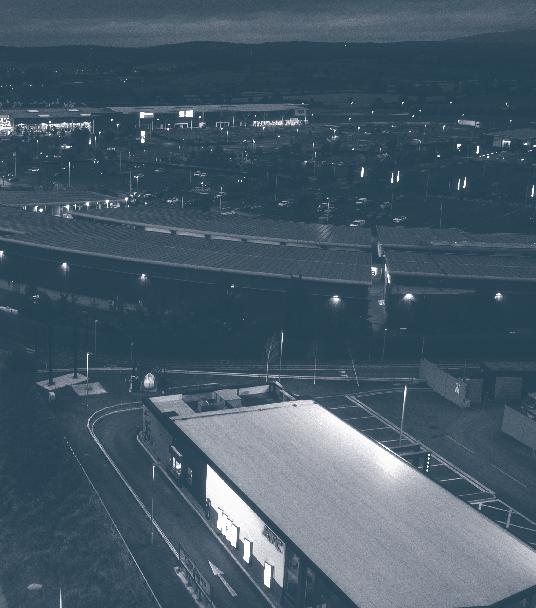
According to the ABC Allotment Survey, 2022, 71.21% of respondents are already growing produce at home, however with an absence of space for community growing and allotments
(26% respondents in the ABC borough said that they would like to see allotment provision in Banbridge). This response was the highest in the borough - there is demand for the creation of new spaces to grow.






















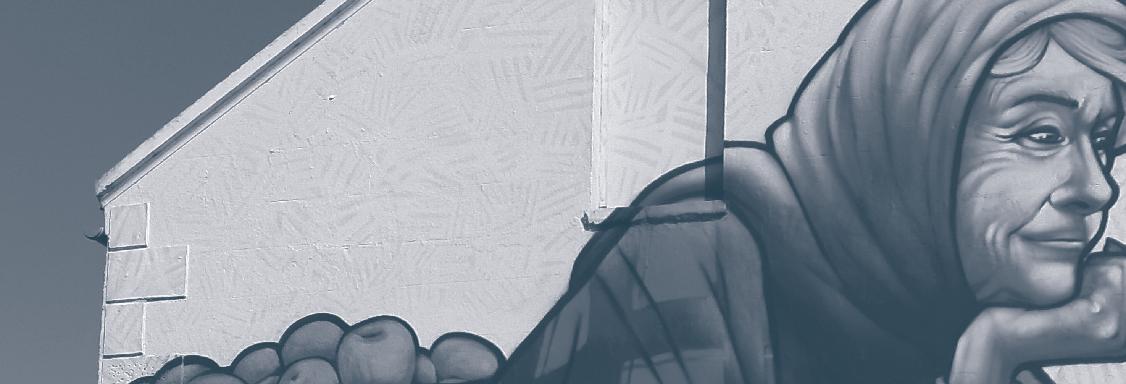
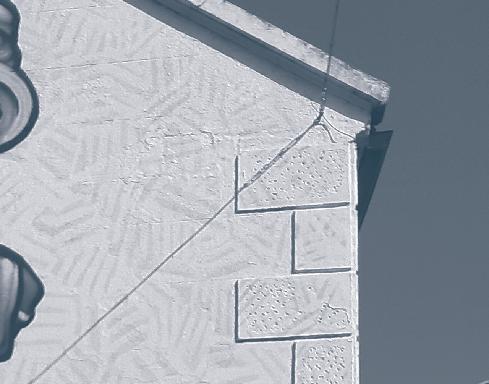


























Five outcomes have been identified that describe the Banbridge that the individuals, groups and stakeholder organisations of the town aspire to live and work in. They have emerged through the discovery stage, engagement with the people and stakeholders of Banbridge, and the 99 big and small ideas that this engagement captured.
These outcomes and the actions that follow in the next section will provide a guiding framework through which people and organisations can shape and deliver their plans and have a positive impact within their own spheres of influence, to collectively and collaboratively deliver the Banbridge of the future.

Bridging Banbridge

A connected and accessible town
Growing Banbridge
An economic hub
These outcomes are further explained on the following pages
Green Banbridge
An environmentally friendly, sustainable and biodiverse town
Creative Banbridge
An innovative and digital town
Healthy Banbridge
An active town
“Old police station. Reimagine it as a pathway through it to the river walk. How exciting to enter at street level and exit via the cells. Introduce a Gobbins style bridge over the river to give access /linkage to/ from solitude park and river/havelock park”
Survey response

The Regional Development Strategy for Northern Ireland 2035 supports a shift away from car use as the dominant mode of transport (and a contributor to environmental pollution), favouring ‘compact neighbourhoods’ and a variety of transport infrastructure options. The borough’s Community Plan is built around connection of people and places. The previous masterplan aspired to create connections through yet unrealised bridges, and the Riverside Walkway Plan (1977) highlighted the issues for connectivity, especially for pedestrians.
A connected Banbridge will have bridges, greenways, trails, good lighting, sign-posting and public transport infrastructure that makes it easy for people to go where they want to go, literally bridging the gaps between parks, green spaces and urban centres. Realising aspirations from previous plans to provide walkways and parkways connecting and enhancing the river.
New and extended walking, running and cycling routes (and culture), around the town and beyond that are accessible to all. It will draw in more passing traffic (and business) from the A1, and local tourist attractions, to keep the town thriving.
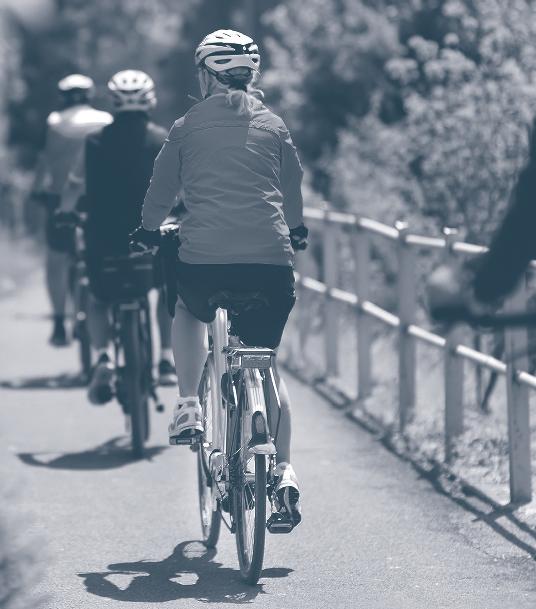
“The last [busy] bus is 17.50 but we [Boulevard] close at 6 - it doesn’t work”
Meeting
“We need to inspire citizenship over consumption in order to care for this planet, Spaceship Earth, our only home, that provides us ‒ and all life ‒ with fresh air, clean water, fertile soil, rich biodiversity, a stable climate and an awesome recycling system. Exploring how it all interconnects can transform our understanding of the world and help us see how, together, our actions can make a difference.”

Eden Project
An environmentally friendly, sustainable and biodiverse town
We are witnessing the effects of climate emergency with increasing regularity, as weather becomes more extreme, pollution increases and biodiversity becomes increasingly under threat. As a town straddling a river, in a time of climate emergency, flood risk alleviation cannot be ignored. ABC Air Quality Action Plan 2022-2024 cites traffic emissions on congested urban roads as the biggest air pollution issue within the Borough, as evidenced during rush hours in Banbridge. The Borough’s Environmental Policy Statement (2018) commits to preserve natural resources, protect the built and natural environment and ensure everyone is involved. Even on the household scale, people can be encouraged and supported to make small changes, for example reducing household waste.
A greener Banbridge is where everyone plays a part in tackling climate change. Businesses explore and share innovative ways to conserve energy and harvest rainwater, while residents explore and implement collective and individual sustainable practices and creative ways to grow and provide good food for all. Hedgerows return to the town centre, and living walls are added, extending biodiverse habitats for wildlife. Local bus routes and hours are extended, including between the Boulevard and the town, making public transport a more viable option. Cycle and pedestrian links improved. Local government and public bodies act as agents of change, acting to mitigate flood risk, increase EV charging and native planting, and turn Banbridge into a flagship case study for best practice in terms of sustainable transport in small towns and rural areas.

Survey response
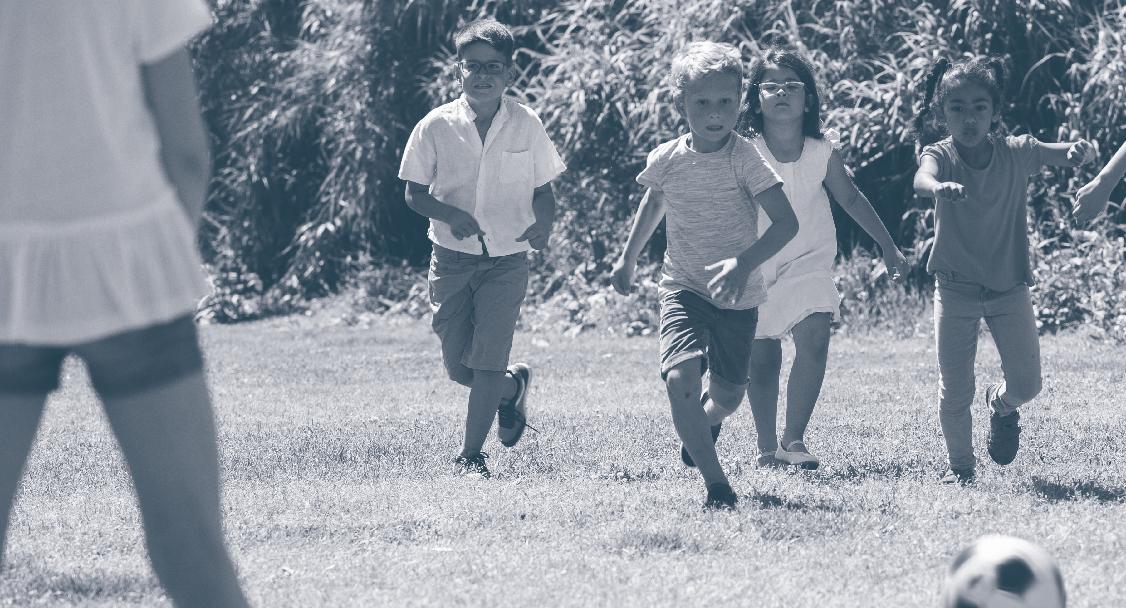
“We need places to go other than the leisure centre”
The connection between place and public health is widely recognised with the Open Spaces Strategy, 2016 recognising the ‘wider socio- economic and health benefits of sport and recreation including job creation, physical fitness and cross-community relationship building’. This Outcome seeks to build on the existing above average health of the people of Banbridge and ensure that the town is doing everything it can to promote healthy lifestyles and make good mental and physical health more easily attainable for all. This includes making better use of existing civic, public space to dwell, play, grow and be creative. Examples might include adding running trails and play spaces, plus promotion of sports such as cycling and river activities.

Active Banbridge promotes overall wellbeing, with a river that thrums with activity, sports clubs that share resources and facilities, weekly park runs, a coffee cart in Solitude Park, community gardens. Pop-up play and temporary social spaces in meanwhile sites will bring new activities and opportunities to gather and connect, and will draw in footfall from further afield, too. The town will have a healthy population, getting and staying active at all ages, and making new friends while they’re at it.
Survey response
“Something needs to be done to combat loneliness.”
“Promoting innovation, research and development, and creativity has been recognised by the NI Executive as a key priority in rebuilding and rebalancing our economy. The creative industries are important drivers of economic and social innovation.”
The role of the Creative Industries, DFC w communities-ni.gov.uk/articles/creative-industries


What’s it all about?
Banbridge was a town of innovators, makers, artists and discoverers, from Francis Crozier to FE McWilliam and Yeats to the Brontes. Today’s innovators need to be supported and nurtured to reach their full potential. Investment per head in the arts is lower in Northern Ireland (£5.07) than anywhere else in the UK (£10.51 Wales) or Ireland (£21.58) and little of that investment reaches Banbridge (only 2% reaches the ABC borough).
We have excellent provision with the SRC Campus and the F.E. McWilliam Gallery and Studio. However, there is a need for artist and creative studios and enterprise space. More public and community art, heritage trails and accompanying interpretation will engage locals and visitors alike. Spaces for community performances, a creative innovation hub, and for buying and selling artisan food will help build cultural identity and drive the local economy.
How can Banbridge be more creative?
Creative Banbridge will have space for local talent to perform, an archive of local histories and a genealogical research facility, in partnership with the local library. The town will nurture and sustain creative businesses and individuals, giving them space to make, share and grow. Strategically placed public art will draw people to the town and enliven civic spaces, while trails and interpretation will bring these and the town’s history to life for locals and visitors alike, celebrating local stories. It will be acknowledged as a digitally connected town, known for its reliable connection, and smart infrastructure, and one where government departments, councils and local partners work together to achieve common goals.

“Would like to expand but in the current climate and with limited support that is not possible”
Banbridge business owner
Banbridge is a strong choice for economic investment, given its geographical location and strong history of industry and entrepreneurship. However, with a lack of new development land and shared workspaces bursting at the seams, economic growth will remain stagnant. 20% of survey respondents said they don’t work in Banbridge, but would like to if more jobs were available. Banbridge needs space for startups and space for more established businesses to grow. Vacancy rates are relatively low at 16.5%, in Banbridge town centre. Ground floors, particularly in the Primary Retail Core, will be expected to accommodate retail use. Vacant buildings beyond the primary retail core and upper floors throughout the town centre could provide additional investment opportunities for housing, mixed use developments and social / leisure facilities. Evening economy and extended retail hours to create a vibrant 24 hour high street.
Banbridge as a hub is a town with more people living, working and enjoying their leisure time there, and more people stopping off at the high street en route to Belfast or Dublin, or as part of their visit to other local attractions. New industry development lands will provide businesses with highly attractive, accessible, wellconnected spaces to start, become established and grow, in and around a newly diverse and 24 hour town centre. Vacant buildings will be adapted and occupied by new businesses. Sustainable and accessible homes are being planned and developed. There will be a vibrant network for business to business sales and collaborations, from legacy family businesses to exciting new ‘glocal’ start-ups - a town abuzz with activity.























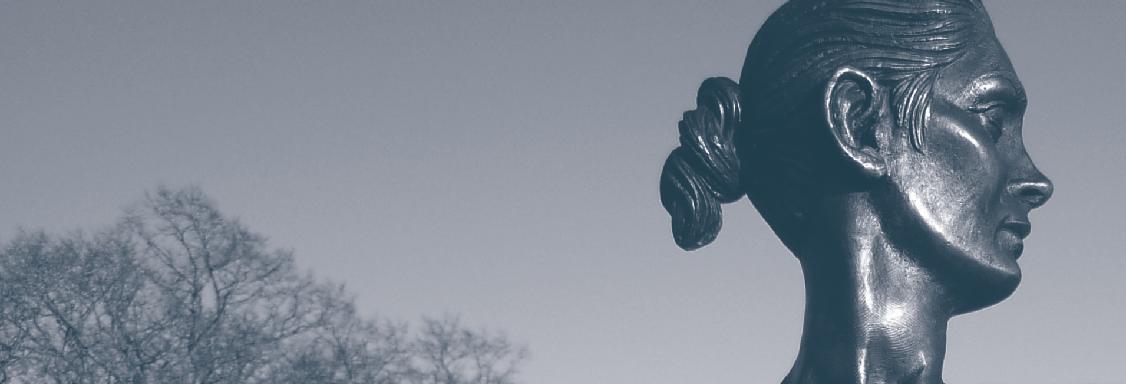





























Over the following pages, 56 Actions have been identified as suggested actions to meet the needs and aspirations articulated by the people, businesses and public bodies of Banbridge throughout this Place Plan. These actions physical and non physical have been thematically clustered into groupings according to their focus and impact. They respond to current and anticipated future issues that the town and planet faces and, if all were delivered by decisionmakers, stakeholders and the people of Banbridge, would collectively deliver the vision and outcomes of the Banbridge Place Plan, bringing about positive change in Banbridge.
8.3
8.4
8.5

8.6
Please note: The implementation of all the outcomes and actions which are being promoted in the Plan will be subject to all relevant consents, including planning permission, being obtained in advance.
A total of 13 Big Ideas are highlighted in bold at the top of each thematic cluster. These are the big ideas within the Banbridge Place Plan that each respond to multiple desired Outcomes and, once delivered, will bring about the most impactful economic, environmental and social change to the town:
AHL1 // Extended F.E. McWilliam Gallery & Studio
AHL2 // More sports and activity opportunities
AHL3 // Historic plaza in Church Square
GI1 // A collaborative sustainable transport audit
GI2 // Banbridge as an EV Charging point stop-off
SP1 // Link Riverside Walk to Church Square and Solitude Park
SP2 // Bridge Havelock Park to Huntly Wood
SP3 // New gateway features
LH1 // Mixed tenure housing developments
LH2 // Cycling network (including the Banbridge to Scarva Greenway proposal)
LH3 // Places to grow together – Allotments, Community Gardens and Sensory Gardens
HSI1 // Digital Creative Innovation Hub
HSI2 // Improved evening economy offering
The sections that follow introduce each of the Thematic Clusters, set out in tables that identify key partners, next steps, timescale and resources required. The actions are aligned to the outcomes which they meet. Accompanying illustrations bring the ideas to life and paint a picture of the future possibilities for Banbridge.
In the tables that follow, each action is set out, along with key partners, next steps, the outcomes they align with and timescales, as follows:

S = short-term (0-2 years) // M = medium term (2-5 years)
L = long term (over 5+ years)
Celebrating the stories of Banbridge, and creating opportunities for play, dwell time, learning, exercise and fun. The focus here is on better utilising and enhancing the town’s existing rich built heritage assets and stories of which there are many. It’s about better promotion of local events. It’s recognising the creative talent and innovation in the town’s past and present, and nurturing this in emerging and future generations.
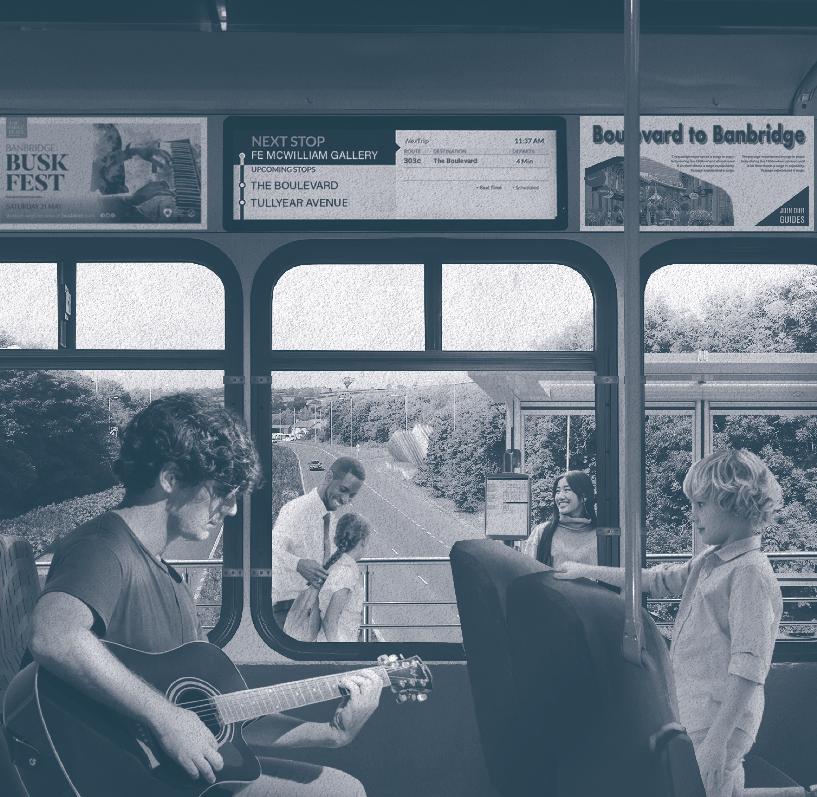
Big Ideas What’s the idea? Suggested PartnersNext steps Resources Needed
AHL1 // Extend F.E. McWilliam Gallery & Studio
The project will involve the extension and alteration of the existing facilities to enhance and develop its offering, providing a flexible space to accommodate all users.
Why It’s important?
With 500,000 visitors in its first decade, the gallery now needs to expand to meet the demand from from local and international visitors and create more engaging opportunities to host events and educational programmes.
ABC Council has successfully bid for £3.5 million to enhance services at the Gallery.
AHL2 // More sports and activity opportunities
Explore options to increase opportunities for structured and unstructured play, sports and leisure spaces which are accessible for all users to include:
• Feasibility study artificial pitches and MUGA’s in line with borough wide policy
• Sports Dome
• Pilot pop-up play spaces
• Pilot river activities such as canoeing, kayaking and angling
Why It’s important?
Banbridge has a strong sporting sector. However infrastructure is lacking for shared play spaces for sports.
AHL3 // Historic plaza in Church Square
Explore an improved setting for heritage assets in the area including
• Traffic study including pedestrian flow
• Upkeep and maintenance of Crozier Monument
• The revitalisation of Church Square
Why It’s important?
Improving pedestrian and traffic flow whilst bringing the historic square back to life will help to enhance the setting in Church Square and create a sense of place and arrival for the town centre.
ABC Council, DFC, DLUHC
Fulfil plans laid out within the already successful Levelling Up bid
Consult with relevant stakeholders throughout the design and construction phase including DFI, Friend of FE McWilliams
Funding already secured
M
ABC Council, Get Moving ABC Partnership, Sport NI, Sports Organisations
Develop concepts for sites Funding M
ABC Council, Banbridge Chamber, DFC/HED, DFI
Find examples of monuments which have been moved/ Review traffic management/ Align with phase 2 public realm works
Funding L
Further Actions
AHL4 // Support artists and creative industries
AHL5 // Facilitate community theatre
What’s the idea?
Explore facilitation of artist support programmes including provision of creative and artist studio workspaces and cross border exchanges drawing from Shared Island partnership study ‘Culture Connects’.
Support the creation/better utilisation of community theatre in existing buildings and spaces in Banbridge.
AHL6 // Celebrate the town’s heritage
Develop programme of action to celebrate the town’s heritage, stories and artefacts.
AHL7 // Family Trees Programme
AHL8 // Review and promote annual Events Programme
Explore facilitating a local genealogy programme, in partnership with relevant local organisations.
Establish an annual local events programme, including regular busking spots, pop up pavilions and seasonal events.
Suggested PartnersNext steps
ABC Council, SRC, Tourism NI Continued liaison with artists
Resources Needed
AHL9 // Strategy for art in the public realm
Cohesive Public Art Programme and Study for public spaces that can be animated, including:
• outreach programmes from key local partners
• delivery of Bow Breaker Public Art
ABC Council, Community and Church halls, Local Businesses, Local Schools
ABC Council, Libraries NI, Local heritage/historical societies, HED
Libraries NI, Local historical society
ABC Council, Banbridge Chamber, BPA, DFC
Research community halls and spaces/ churches/ schools
TimescaleOutcomes
FundingS
ABC Council, BPA, DFC, DFI, Tourism NI
Commission feasibility study to explore options and associated costs
Liaise with potential facilitators and funders
Evaluate current and past offering and test new ideas with audiences
FundingM
Evaluate current and past offering and test new ideas with audiences
Funding M
PartnersS
FundingS
FundingS
AHL10 // New pitches Deliver construction of pitches and pavilion building at Banbridge High School.
AHL12 // Share
Persue heritage funding opportunities to restore and repair historic built fabric in the Areas of Townscape Character, and beyond.
Celebrate and support what’s on in Banbridge through
• Collaborative development of Urban ABC website. Taking a partnership approach to the promotion and marketing of Urban ABC and Visit Banbridge, encouraging local businesses and community groups to use this.
• Local stakeholders, businesses, and service providers better promoting and raising awareness of their offering in the area, such as Banbridge Youth Resource Centre and Library extended hours.
• Including running trails around pitches, events (such as a 10k run) and establishing a Junior Park Run.
• Portfolio of heritage, culture and biodiversity walking trails discovering the area in partnership with local groups.
• Develop and implement associated trail infrastructure such as signage, interpretation panels - including audio and braille.
ABC Council, EA, SRC Engage with Project Team to ensure delivery
ABC Council, AHF, Community and Church halls, HED, Local Businesses, Local Schools
ABC Council, EA, Local historical society, Libraries NI
Liaise with potential property owners and funders
FundingM
FundingM
AHF, HED, Local historical society, Libraries NI
Create and implement audience development strategy
TBC S
Public meeting to establish a group to champion. Map and measure potential routes. Research, map and measure potential routes and stories. Include trails on ABC Council app
Partners funding S
Focusing on ways to respond to climate emergencies and make Banbridge’s households, businesses and services more environmentally responsible. Actions here build on Banbridge’s history of innovation, asking if Banbridge can be a trailblazer in this important area, too, leading the way towards sustainable rural transport solutions for a less car-dependent world, harnessing and protecting its natural resources and becoming a place known for its fast, reliable infrastructure and car charging.

Big Ideas What’s the idea?
A study on the future of transport in Banbridge and surrounding rural areas to explore and promote walking, cycling, public transport and bike, car and ride sharing in preference to single occupancy car use.
The study should also be reviewed alongside DfI Local Transport Studies / Plans which inform the LDP to consider existing connections in Banbridge, including:
• Improving the physical connection between the Boulevard and the Town Centre.
• Improving busy bus service coverage and promotion between the Town Centre - FE McWilliam Gallery – the Boulevard and neighbourhoods
• Connection of Huntly Wood to the town via a new footpath along Huntly Road or a new bridge from Havelock Park to Huntly Wood (Ref 8.3)
• Weighing up the case for a ring road at Dunbar and Ballygowan Roads,and potential impacts (positive and negative) against environmental considerations.
Why it’s important?
The Regional Development Strategy for Northern Ireland 2035 supports a shift away from car use as the dominant mode of transport. This will prepare the town and rural catchment for future reduction in car dependency as well as assessing potential impact on Banbridge town centre.
Aim to have a high number of fast chargers that attract North-South traffic, on road and off road and within new neighbourhoods and key locations.
Why It’s important?
AV Charging point hubs make stopping off at a location more desirable. A hub in Banbridge will encourage commuters on the A1 to halt at the town.
Suggested PartnersNext steps
ABC Council, DFC, DFI Undertake a study to assess the feasibility of new connections.
Source funding for audit and for options for new connections
Resources Needed TimescaleOutcomes
Funding
Collaborative approach
ABC Council, DFC, DFI, Energy providers Understand feasibility of sites and develop concepts
Funding Partners L

GI3 // Facilitate digital infrastructure support programmes
GI4 // Implement smart infrastructure
GI5 // Opportunities for businesses to invest in sustainability energy and promote good practice
GI6 // Public bodies as Change Champions
Advice and mentoring on making the most of digital connectivity in Banbridge and providing access to funding available to assist businesses to be active in digital transformation.
ABC Council, BPA, DFC, Invest NI Identify facilitators PartnersM
GI7 // Biodiversity audit and strategy
Smart street furniture, smart car parks and connectivity in public places.
ABC Council, DFCAlign with upcoming public TBC M
GI8 // Implement ABC Net Zero Road Map Analysis
GI9 // Harness the river
Encouraging businesses to investigate new sustainable energy options and drive forward net zero solutions. Could include site visits and collaborative working.
ABC Council, DFC, DFI, Local businesses, Schools, Sector leads
Identify areas and sites for learning potential Partners S
Public bodies showing shared leadership in adopting sustainable behaviours.
Research ideas and inspiration on initiatives such as zero waste, rewilding, tree planting, carbon neutral, sustainable travel, employment support and social value procurement
Including new sustainable native planting, rewilding, protection of existing species, including bats and wildflowers, and reduction and removal of invasive species. Produce an Action Plan for Banbridge, including pilots.
To achieve 2030 and 2050 targets
CPSP Collaborative research and feasibility options
Sharing of best practise
PartnersS
Explore the River Bann to further understand flood risk and the potential for water energy technologies and protecting and enhancing environmental quality of the river and its environs.
ABC Council, DFI Commission auditFundingS
ABC Council, CPSP, DFI
Collaborative research PartnersM - L
ABC Council, DFI, QUB, UU Identify working groupPartnersM
Investment in the natural spaces and places that make Banbridge unique, and a pleasant place to be. Key actions include new footbridges and boardwalks at strategic locations along the River Bann that will link existing parks and walkways, opening up many more accessible options for walks, runs and bike rides. Others focus on enhancing existing amenities and under utilised space, plus better signposting of the town from the A1, through lighting, public art and programming events and pop-up opportunities such as retail, food or play.
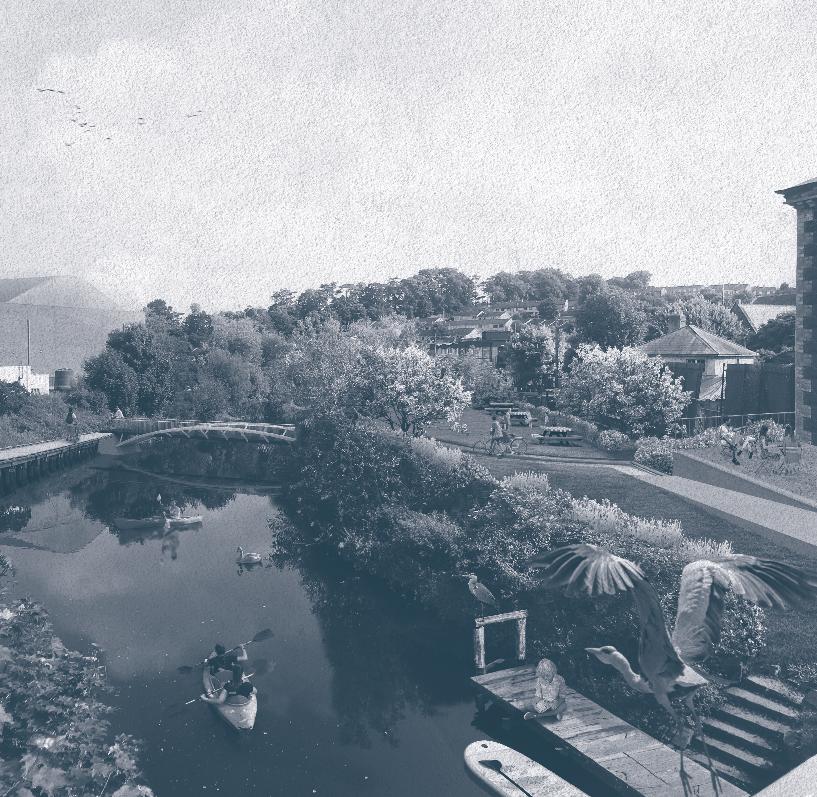
Big Ideas What’s the idea?
SP1 // Link Riverside Walk to Church Square and Solitude Park
New footbridge and boardwalks to increase mobility, create longer walking routes and establish new connections that link existing public realm and green spaces to the river and to each other.
Why It’s important?
A key, but unrealised action from the Banbridge Town Centre Masterplan (2016), these bridges will create a less fragmented town centre. The bridges will enhance the river experience, offering opportunities to engage with the town’s biodiversity and take longer and more variable walks across the town.
SP2 // Bridge Havelock Park to Huntly Wood
A new bridge to establish longer walking routes, linking green spaces and creating new ways to get around.
Why It’s important?
Residents of Banbridge have asked, throughout the engagement for longer walks and cycling and running routes. This strategically placed pair of bridges could link Huntly Wood (which is currently hard to access) to Havelock Park and through to the RIverwalk and the town beyond, opening up lots of new and interesting, longer routes and ensuring that existing resources are better used.
SP3 // Implement new gateway features
New inviting gateway features along the Belfast Dublin Economic Corridor and at other key locations. These will form part of a strategic gateway strategy along with new signage at gateways and entrances, including:
• Implementing the Bow Breaker and other new public art
• Bespoke Signage scheme Boulevard to Town Centre
• Implementation of flag fields at entrance points.
Why It’s important?
With Banbridge’s unique location on the A1, new gateway features will act as destination landmarks, marking the arrival to the town.
AHF, ABC Council, DFC, DFI, HED Identify funding to investigate through initial design and planning stage
ABC Council, AHF, DFI, HED, Sport NI Identify funding to investigate through initial design and planning stage
Partners
ABC Council, Arts Council, BPA, DFC, DFI, Tourism NI
Identify funding for potential sites and concept ideas
Funding M

SP4 // Enhance Solitude Park
Encourage dwell time in Solitude Park by ensuring it is an attractive, welcoming and usable green space. Ideas include enhanced and refreshed landscaping, a pop-up cafe cart, programming events in the amphitheatre, and exploring extending opening hours. As well as encouraging the community to hire it through promotion and making the terms publicly available (pilot this).
SP5 // Shine a light on Banbridge
Use lighting design as an intrinsic tool to enhance Banbridge streets and public spaces:
• Create a lighting strategy for Banbridge, enhancing public space by developing an innovative and green approach to Banbridge town lighting.
• To include a seasonal lighting upgrade within the town centre.
SP6 // Enhance public amenities
Review existing offerings and explore:
• Public toilet offerings and the need for additional provision, including Changing Place facility.
• Provision of additional public seating, concrete games tables and free access to healthy tap water.
SP7 // Meanwhile use of underutilised spaces
SP8 // Open up Civic Building Grounds
Create public benefit opportunities by initiating permanent and/ or temporary projects on disused or fenced off space, which are currently counterproductive to town regeneration. Projects will ideally have a green, social or play element and be welcoming and accessible to all.
Improve public access to civic building grounds and green space, including restoring the McClelland Water Fountain to full operation.
SP9 // Implement findings of ABC Car Parking Strategy, 2023
Implement in conjunction with future government policies on reducing car dependency.
ABC Council, DFC, Sport NI, Tourism NI Evaluate current offering and make recommendations for pilot activities
ABC Council, DFC, DFI
Explore if a lighting strategy for Banbridge could be delivered that considers environmentally friendly and low energy lighting
FundingS - M
ABC Council, DFC, DFI
Evaluate current offering and make recommendations
Funding S - M
ABC Council, AHF, DFC, HED
Identify potential sites and make recommendations for meanwhile use
ABC Council Create and implement plan for future use of ground space
Funding S - M
TBC S
ABC Council, DFC, DFI
Create implementation plan and deliver
TBC S
Focusing on Banbridge as a brilliant place to live. Actions include those that promote living high streets that meet the demand for safe, welllit places to be. Beyond the high streets, actions respond to demand for allotments, spaces to play and do sports. This cluster suggests ways for the community to collaborate, including in response to the pertinent issues of poverty and loneliness.
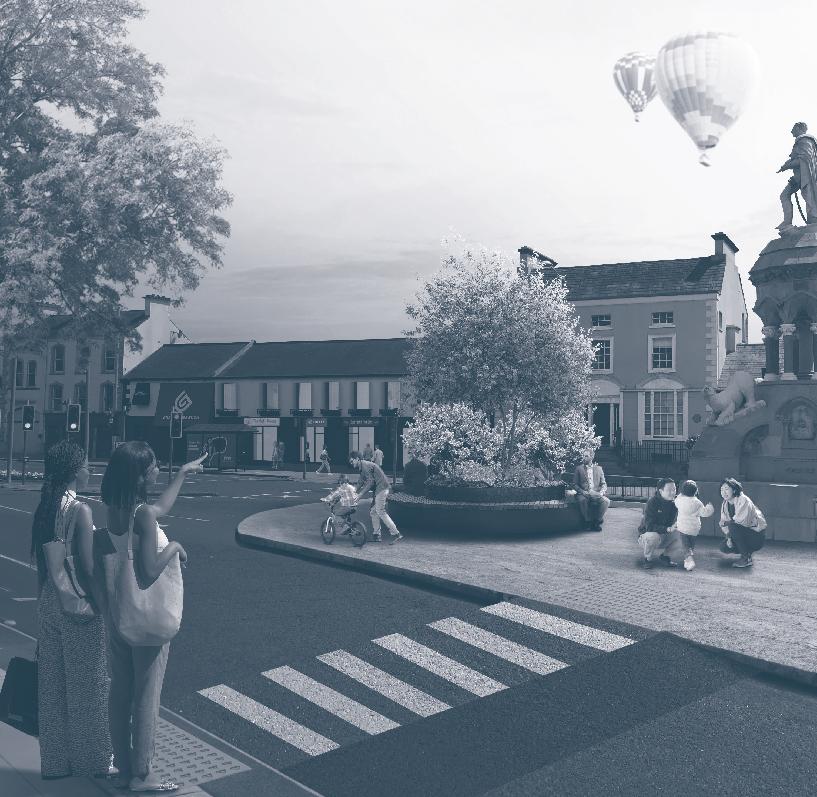
LH1 // New Housing for Banbridge
Mixed tenure housing developments which would reduce housing need and creating liveable, walkable neighbourhoods, where residents have amenities to shop, work, rest and play within close range of home.
Why It’s important?
Banbridge Town exhibits one of the highest levels of social housing need in the borough. This will enhance mixed tenure housing and increase the number of affordable units conveniently located to the services and facilities of Banbridge.
LH2 // Cycling infrastructure including the delivery of Banbridge to Scarva Greenway proposal
A network with segregated paths where possible. Infrastructure such as further cycling parking, maintenance points, signage, cycling hubs at key locations, potential for cycle hire facilities.
Explore bringing Sustrans presence to Banbridge.
Why It’s important?
Cycling is not only healthy but also a sustainable and affordable mode of travel. Creating more active travel opportunities through the provision of a better cycling infrastructure has the potential to lead to a healthier population, reduce traffic and congestion and the need for car parking, and contribute to better mental health, therefore aligning with multiple outcomes.
LH3 // Places to grow together
Explore opportunities for provision of allotments, community gardens and sensory gardens including the opportunity to enhance biodiversity.
Why It’s important?
There is demand for allotment provision in Banbridge, and desire to “grow your own” (26% of respondents in the ABC borough said that they would like to see allotment provision in Banbridge - Allotment Survey) This response was the highest in the borough.
LH4 // Town centre living
Investigate the opportunity for further town centre living, including living above shops and utilising vacant buildings.
LH5 // Place to play
Maintain and upgrade existing structured and unstructured play spaces and explore adding more
• Upgrade existing play parks through a capital play programme
• Utilise and maintain current green spaces for free non structured play. Huntly Park and Hillhead Park x 2 spaces.
• Pop up play in town centre locations including revitalised public realm areas
LH6 // Encourage collaboration
Local sports clubs, community groups, businesses and schools to share resources and use of facilities.
ABC Council, AHF, BPA, DFC, HED, NIHE, UAH
LH7 // Climate action toolkit
We all have a part to play. Banbridge residents can help tackle the climate emergency, starting in the home.
• Create a residents and community toolkit about climate action tips (Inc. growing food, litter collection, saving water)
• Build community green skills and capacity
• Launch initiatives such as ‘No mow May’.
LH8 // Community led programming
Creating opportunities for democratic programming including:
• Youth led programming designed by young people, to include a football academy, Young Enterprise. Dragons den style market for young people and regular under-18s disco
• Develop an intergenerational activity programme to foster connections between age groups.
Engage with property owners, property developers and statutory bodies and explore funding streams
Funding Initiate Discussions
S - M
ABC Council, NIHE, Sports and outdoor organisations, Sport NI
Implement actions and scope out opportunities Funding Partners S - M
EA, Local Community groups, Local sports groups, Schools, Sports Forum
ABC Sports Forum to facilitate discussions for future collaboration
ABC Council, CVSP, DFI Develop toolkit with partners and communities
Partnerships S
Collaboration S
ABC Age Friendly Alliance, Banbridge Youth, CVSP, Local Community Groups, Local Sports groups
Create a diverse community focus group led by Community
Partners Collaboration Funding
S
LH9 // Small grants
Raise awareness of funding streams that local community groups and societies can avail of such as
• Participatory Budgeting
• Live here/love here
• Small Floral Grant Scheme
• F inancial Assistance Policy
• Awards for All
Tackle loneliness in the town and environs by creating more opportunities for interaction between diverse people and groups. Could include:
• ‘Chatty cafes’ in which cafes designate a table that is clearly marked as one to sit at.
• ‘Chatty benches’ extension of current provision
• ‘Living Rooms’ (set up in public spaces to encourage strangers to sit down and chat together, for wellness)
• ‘Walking Friends’ - go for a walk and meet people
• Repair Cafes and swap shops.
Make good food more affordable for those experiencing poverty by
• Providing support to families in crisis
• Supporting Food Banks and Social Supermarkets, whilst also working to remove the need for them.
• Exploring creative ways to provide good food for all through the local food economy.
Develop a toolkit to make Banbridge more accessible in collaboration with IMTAC and other partners. This should include
• Pilots, case studies and best practice/shop mobility.
• Pilot initiatives that incentivise (and thereby normalise) walking up and down the hill - eg. fobs one month of the year and age category prizes for the most times climbed.
• Exploration of wheelchair buddy schemes.
ABC Council, All Community Planning Partners, CVSP, Local Community Groups
Make a plan for participatory budgeting programme
Directory of funding opportunities
Funding and Partners
ABC Council, ABC Loneliness Network, BPA, DFC, Local hospitality businesses, SRC
Refer to ‘Campaign to end Loneliness’, and UK government’s ‘Connected society: Strategy for tackling loneliness’
PartnersS
ABC Council, CVSP, DFC, Local churches and businesses
Initiate focus group of partners
Funding and Partners S
ABC Council, Age Friendly Alliance, DFC, DFI
Initiate focus group of partners to establish plan
Funding and Partners S

This cluster of actions focuses on Banbridge as a business hub, from supporting individuals, startups and micro businesses through, for example, flexible co-working space for a post-pandemic, hybrid working world, to the identification of further land for larger developments.
Investing in people, companies, places and spaces will develop, diversify and grow the current economic offering across the settlement development limits of Banbridge and in the ‘high street’ area.
Big Ideas What’s the idea?
HSI1 // Digital Creative Innovation Hub
A multi disciplinary resource for artists and makers including SRC graduates and others in the town with an interest in arts, film and digital media.
Why It’s important?
Banbridge has a history of creativity and innovation and still turns out a large number of artists and makers through the SRC. An innovation hub could build on relationships between education providers and the town, providing the infrastructure to retain some of the creative graduates in the town and resource them to kick-start their careers, while making the town more vibrant. A creative town is better for everyone.
HSI2 // Develop evening economy offering
• Pilot an Evening Economy Positive Action Group (PAG) With collaborative members from the business community, entertainers, and community representatives to engage collectively to build a new offering for Banbridge and explore extended opening hours.
• Review Evening Night Time Economy (ENTE)Plan for the Borough including Purple Flag status
Why It’s important?
A vibrant nighttime offering can increase local investment and employment as well as creating a better social environment, encouraging more people to visit Banbridge in the evenings and ultimately creating a safer town centre.
78% of survey respondents felt the town’s evening economy was poor to fair.
Suggested PartnersNext steps
ABC Council, DFC, EA, GOT, Local creative and artist groups, SRC
Resources Needed TimescaleOutcomes
Identify potential sites and funding FundingL
ABC Council, Banbridge Chamber, BPA, DFC, Local musicians, artists, theatre and community groups, PCSP
Develop an Evening Economy Action Group (PAG)
Review ENTE Plan
Partners Collaboration Initiate discussions and focus group to establish a plan.
S
HSI3 // Further investment in public realm
Deliver Public Realm and Environmental Improvements
• Phase 1 town centre, linkages and associated signage
• Phase 2 and Phase 3
• To improve accessibility, crossing points and connections to and from the town centre.
HSI4 // More Enterprise Hubs
Create spaces for startups, micro businesses and coworking. This could provide a means to bring empty units and upper floors back into use.
Expand the provision of enterprise hubs in Banbridge Create new inclusive and inspiring enterprise space for start-ups, micro businesses, hybrid working and those seeking space to co-work.
Ensuring businesses have access to digital infrastructure and services. Developing a more collaborative network of businesses, where the exchange of knowledge is supported and connections are made.
HSI5 // Deliver Town Centre support, Revitalisation and Regeneration
HSI6 // Enhance market offering
Shop fronts, business facades and town centre support. To include support initiatives such as capacity building, loyalty schemes with traders/ businesses - discount cards for locals.
ABC Council, DFC, DFI Delivery of phase 1 Develop concepts for phase 2 and phase 3
BPA, Business Enterprise Centre, DFE, Invest NI, Local property owners
Engagement
Feasibility study to look at potential site or buildings available in the town centre
ABC Council, Banbridge Chamber, BPA, DFC
Promotion and development of flower and food market provision and seek to explore new opportunities from the ABC Market Strategy.
ABC Council, Banbridge Chamber, BPA, DFC
actions from ABC Market Strategy, 2023
HSI7 // Maximise Belfast to Dublin Economic Corridor opportunities
• Development of clusters in growth sectors along economic corridor
• Promote investment messaging of the economic corridor
• Promote opportunities as gateway to internal and external markets to international investors
• Develop green infrastructure projects along the economic corridor
• Maximise partnership working with Council’s and other economic stakeholders along the economic corridor
HSI8 // Explore Business Improvement District (BID)
HSI9 // Identify skills gaps and promote local opportunities
Look at best practice and case studies from other places that have (and haven’t) implemented BIDs. Consider thematic BID.
ABC Council, DFE, Invest NI Consider and implement findings of Dublin Belfast Economic Corridor
Feasibility, 2023
Resources Needed TimescaleOutcomes
FundingS - M
HSI10 // Adapt and reuse vacant properties
Focus on the employability and skills agenda, to meet the future needs of the labour market and supply of skills.
• Establish better integration between education and training providers, employers and stakeholders to ensure a strategic approach to meet future skills needs
• Upskill/ reskill those in employment, unemployed, underemployed or economically inactive
• Attract skilled labour to the area
• Engage with schools and colleges to present the current and future local job opportunities in growth sectors
Engage with owners on development/meanwhile uses Including:
• Supporting refurbishment and re-utilisation of the listed former Police barracks for public benefit
• Empty to Occupied future rounds as a vehicle to stimulate the economy and activate street frontages.
• Use upper floors for housing
ABC Council, Banbridge Chamber, BPA, DFC, Local Businesses
Investigate merits of (and appetites for) introducing a Business Improvement District
PartnersS
ABC Council, ABC Labour Market Partnership, Banbridge Youth and Resource Centre, DFC, EA, Local Businesses, SRC
Research and establish plan PartnersS
ABC Council, AHF, DFC, HED, Invest NI, Local Estate Agents and developers, NIHE, Private owners, UAH
Identify derelict/vacant sites
Initiate discussions with owners
Partners S - M

‘Assessment of Economic Land Availability and Need’ study, to harness vacant or underused publicly owned land for repurposing for greater public benefit, along the (A1) Dublin Belfast Economic Corridor within the ABC Council area:
• Engage with public and private landowners.
• Work closely with other economic agencies such as Invest NI to understand levels of both indigenous and inward investment demand to profile future needs.
• Economic Development land assessment to consider suitable Development Opportunity Sites, vacant buildings last in use for economic development purposes and undeveloped zoned economic development land. This assessment should inform consideration of existing and future need for ‘business start-up space and development land along the A1 Dublin to Belfast corridor within the ABC Council area’’.
• The study should be carried out alongside the LDP as the means to zone / rezone economic development lands within the Council area.
• Support start-ups, business growth potential of Banbridge business base and attract inward investment opportunities
• Develop better understanding of the local business sectoral strengths and support new and emerging sectors
• Build international linkages to support new investments
• Support growth in innovation & digital technologies
• Promote the benefits of doing business in Banbridge
Commission assessment study
S
ABC Council, BPA, DFC, Invest NI Evaluate current opportunities and make recommendations for growth
Partnerships Collaboration S
ABC Council, Existing local accommodation providers, Invest NI, Tourism NI
S
- M























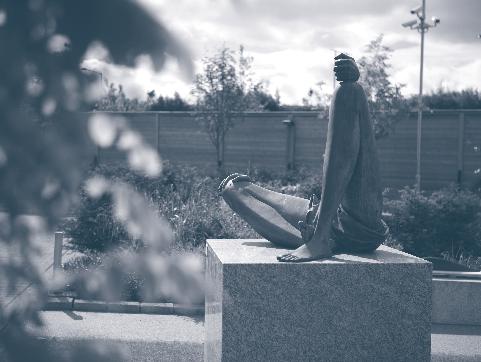



























This table is based on a Theory of Change and a Logic Model. It is a visual tool that demonstrates how actions (Activities) lead to the desired change (Outcomes). It illustrates how the investment and activities contained within the Banbridge Place Plan will have an impact and legacy on the town.
ResourcesActivity ClustersKey Outputs: Deliverables Outcomes: The ResultImpact Overview
• Public investment
• Community Planning Partners
• Business owners
• Residents
• Infrastructure
• Research
• Arts, heritage and leisure
• Green innovation
• Spaces, places and natural environment
• High Street and Investing
• Living here
Physical, conceptual, research and partnerships to include 56 actions of which 13 are considered Big Ideas:
• Extended F.E. McWilliam Gallery & Studio

• More sports and activity opportunities
• Historic plaza in Church Square
• A collaborative sustainable transport audit
• Banbridge as an EV Charging point stop-off
• Linking Riverside Walk to Church Square and Solitude Park
• Bridge Havelock Park to Huntly Wood
• New gateway features
• Mixed tenure housing developments
• Cycling network (including the Banbridge to Scarva Greenway proposal)
• Places to grow together – Allotments, Community gardens and sensory gardens
• Digital Creative Innovation Hub
• Improved evening Economy offering
• Bridging Banbridge
• Green Banbridge
• Healthy Banbridge
• Creative Banbridge
• Growing Banbridge
• An inspiring market town
• A town of innovative industries and active citizens, makers, and discoverers
• An inviting hub of opportunity
• A town that places importance on its river
















The Community Planning Partnership recognises that in order to successfully deliver the actions from this place plan, engagement and collaborative relationships is key and will continue to engage with its partners, the Community Voluntary Sector Panel, local community groups, businesses and residents. Implementation of the place plan, funding and delivery of the actions is the collective responsibility for a wide range of partners.
Council’s Community Planning Department will monitor the progress of each action, the progress of outcomes will be measured against baselines within the population indicator place dashboards. The Place Board Sub Committee will report on the progress of the delivery of place plans and priorities within the places to the wider partnership.
The Community Planning Partnership appointed Studio idir + Starling Start to develop the Banbridge Place Plan. The Partnership would like to thank Studio idir and Starling Start for their commitment and expertise.
To find out more about Studio idir and Starling Start, please visit: w studioidir.com w starlingstart.com
Glossary
ABC Council
Armagh City, Banbridge and Craigavon
Borough Council
ACNI
Arts Council Northern Ireland
AHF
Architectural Heritage Fund
ASB
Anti Social Behaviour
ATU
Atlantic Technological University
BDEC
Belfast Dublin Economic Corridor
BID
Business Improvement District
BPA
Business Partnership Alliance
CAP
Christians Against Poverty
CPSP
Community Planning Strategic Partnership
CVSP
Community & Voluntary Sector Panel, ABC Council
DAERA
Department for Agriculture, Environment and Rural Affairs
DFC
Department for Communities
DFE
Department for the Economy
DFI
Department for Infrastructure
DLUHC
Department for Levelling Up Housing and Communities
EA Education Authority
EBR
East Border Region
GoT Game of Thrones
HED
Heritage Environment Division
ICBAN
Irish Central Border Area Network
IMTAC
Inclusive Mobility and Transport Advisory Committee
NIHE
Northern Ireland Housing Executive
NISRA
Northern Ireland Statistics & Research Agency
NMNI
National Museums Northern Ireland
PAG
Positive Action Group
PCSP
Policing and Community Safety Partnerships
PRONI
Public Records Office Northern Ireland
QUB
Queen’s University Belfast
SRC
Southern Regional College
UAHS
Ulster Architectural Heritage Society
UU
Ulster University

